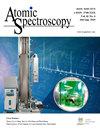UV Induced Advanced Oxidation Process For The Degradation Of Organic Mercury And Its Application To Mercury Speciation By Atomic Fluorescence Spectrometry
IF 2.3
2区 化学
Q1 SPECTROSCOPY
引用次数: 0
Abstract
A new online advanced oxidation process with high efficiency was proposed for the degradation of organic mercury. The oxidation process is based on a high-efficiency photooxidation reactor in which the reaction tube was passed through a low-pressure mercury lamp. The reactor provided efficient irradiation which resulted in the complete degradation of methylmercury and ethylmercury within 4 s and 6 s, respectively. The highlight of this method is the removal of oxidants and high temperature. The oxidation process is extremely high efficiency and therefore is easy to be coupled with flow injection (FI) and high-performance liquid chromatography (HPLC). In FI system, complete oxidations of organic mercury can be accomplished in the plain medium of 0.5% (v/v) HCl, 1% (v/v) HNO3 and H2O, therefore, simple Hg aqueous standard calibration curves can be used to calibrate both inorganic and organic mercury. The detection limits of Hg, CH3Hg and CH3CH2Hg were found to be 0.02 ng mL. In HPLC system, the detection limits were calculated to be 0.55, 0.84, 0.56 ng ml for Hg, CH3Hg and CH3CH2Hg, respectively. In addition, the method provided good repeatability (< 5% RSD) for both systems. The developed method was validated by determination of certified reference material (GBW 10029, tuna fish) and was further applied in speciation of mercury in spiked environmental waters and biological samples.紫外诱导高级氧化法降解有机汞及其在原子荧光光谱汞形态分析中的应用
针对有机汞的降解问题,提出了一种新的在线高效高级氧化工艺。氧化过程基于高效光氧化反应器,其中反应管通过低压汞灯。反应器提供了有效的辐照,分别在4 s和6 s内导致甲基汞和乙基汞的完全降解。这种方法的亮点是去除氧化剂和高温。氧化过程效率极高,因此易于与流动注射(FI)和高效液相色谱(HPLC)相结合。在FI系统中,有机汞的完全氧化可以在0.5%(v/v)HCl、1%(v/v)HNO3和H2O的普通介质中完成,因此,简单的汞水标准校准曲线可以用于校准无机汞和有机汞。Hg、CH3Hg和CH3CH2Hg的检测限为0.02 ng/mL。在HPLC系统中,Hg、CH3 Hg和CH3CH2 Hg的检测极限分别为0.55、0.84和0.56 ng/mL。此外,该方法为两种系统提供了良好的重复性(<5%RSD)。所开发的方法通过测定经认证的参考物质(GBW 10029,金枪鱼)进行了验证,并进一步应用于加标环境水域和生物样品中汞的物种形成。
本文章由计算机程序翻译,如有差异,请以英文原文为准。
求助全文
约1分钟内获得全文
求助全文
来源期刊

Atomic Spectroscopy
物理-光谱学
CiteScore
5.30
自引率
14.70%
发文量
42
审稿时长
4.5 months
期刊介绍:
The ATOMIC SPECTROSCOPY is a peer-reviewed international journal started in 1962 by Dr. Walter Slavin and now is published by Atomic Spectroscopy Press Limited (ASPL). It is intended for the rapid publication of both original articles and review articles in the fields of AAS, AFS, ICP-OES, ICP-MS, GD-MS, TIMS, SIMS, AMS, LIBS, XRF and related techniques. Manuscripts dealing with (i) instrumentation & fundamentals, (ii) methodology development & applications, and (iii) standard reference materials (SRMs) development can be submitted for publication.
 求助内容:
求助内容: 应助结果提醒方式:
应助结果提醒方式:


